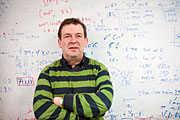- Number 345 |
- September 5, 2011
Theory center deputy pursues lattice QCD research

David Richards
As a young man, David Richards thought he was headed for a career in mathematics. The Wallingford, England, native excelled in the subject throughout his schooling and headed off to Cambridge intent on that degree. But, working in an accounting office in the days when accounting was done with, as he puts it, "bits of paper and double-entry account keeping," disabused him of the notion of that application of math.
"It was," he noted, "very boring."
By the time he completed a bachelor's degree and beyond in math, he'd already determined that he was going to head in a different direction.
"I just knew I was not cut out to be a pure math type," he said.
Now he is deputy director of the Center for Theoretical and Computational Physics at DOE's Jefferson Lab.
Richards earned a Ph.D. at Cambridge University. There, he worked on Perturbative Quantum Chromodynamics under James Stirling and Peter Landshoff. He then went to Southampton University for his postdoctoral work in particle theory, where he, in his words, "first dipped my toes in the water of lattice."
He first came to the United States in 1986 to work as a postdoc at Argonne National Lab in the High Energy Physics division. While there he met the woman who would become his wife.
"We were both the worst badminton players at the Oak Park YMCA," he said with a laugh.
Her pursuits were decidedly unscientific. A fashion major, she came from a family of artists and had worked at the Art Institute of Chicago.
They returned to the U.K. in 1988 for Richards' work as a postdoc in particle theory at the University of Edinburgh, a major center for lattice QCD work. With its own ICL supercomputer, the group at Edinburgh came in with some impressive results. The UKQCD national collaboration allowed the group to purchase another supercomputer, which Richards describes as "a big box that looked like a wardrobe."
In the early 1990s, Richards met Nathan Isgur, who would become JLab's chief scientist, when Richards organized a workshop at Edinburgh at which Isgur spoke. When Richards and his wife were considering a return to the U.S. in the late 1990s, he rang Isgur up and found that the lattice group was about to begin. Richards came to Jefferson Lab as a staff scientist and joint faculty member at Old Dominion University in 1999. He became a full-time staff scientist in 2002 and served as acting Theory Center leader from September 2009 through October 2010. He was appointed deputy director of the Theory Center in mid-October 2010.
"This is a big experimental lab and a big theory lab," he noted. "Together, we have this amazing amalgam of theorists and experimentalists and an outstanding opportunity for the two to come together. Being at a lab like this, and having the opportunity to actually talk to and interact with the people who are doing the experiments, allows us all to see the whole picture."
Richards' current research focus is aimed at garnering a better understanding of so-called "excited states." These are subatomic particles that were once the familiar protons and neutrons, but now have additional energy. The experimental determination of their masses and properties is an important effort at Jefferson Lab.
Richards and his colleagues use supercomputers at Oak Ridge National Lab, and the high-performance GPU-enabled (graphics processing unit) clusters at Jefferson Lab, to compute the masses and properties of these excited states from first principles, using lattice QCD. Comparing these calculations with experimental data provides crucial insights into the nature of matter and how the masses of so-called hadronic matter, such as protons and neutrons, arise from QCD.
A particularly exciting recent calculation is that of the masses of so-called "exotic mesons," mesons that cannot be constructed from straightforward excitations of a quark and an antiquark, the fundamental building blocks of QCD. The search for such mesons is the aim of the GlueX experiment with CEBAF at 12 GeV. Richards and his colleagues predict that there will be exotic mesons at a mass that will be accessible to GlueX, underpinning the scientific imperative for the experiment.
Throughout his career, Richards has received numerous awards, including scholarships at Cambridge and an advanced Fellowship at Edinburgh. He serves on committees such as the Lattice QCD Executive Committee and was the co-organizer of Lattice 2008, the 26th International Symposium on Lattice Field Theory held in Williamsburg, and a panel convener for Forefront Questions in Nuclear Science and the Role of High Performance Computing, held in 2009 in Washington, D.C.
Richards and his family live in Williamsburg. He is an avid cyclist, shooting for 100 miles a week, although he confesses to being a "fair-weather rider" who achieves his goal only part of the year. His wife, who went on to earn an MBA, worked in marketing with large pharmaceutical companies after their return to the U.S., and their son is a high-school sophomore and basketball player.Submitted by DOE's Jefferson Laboratory
